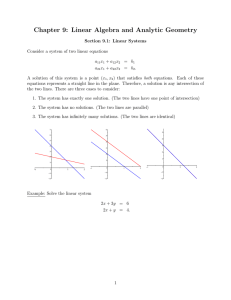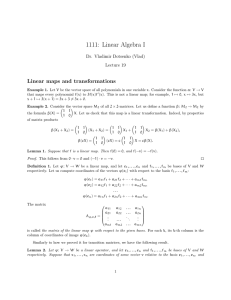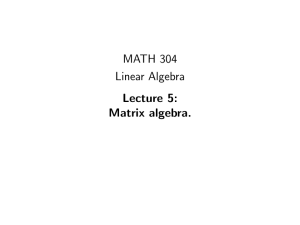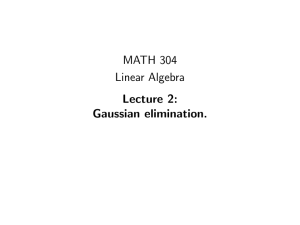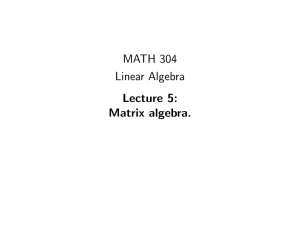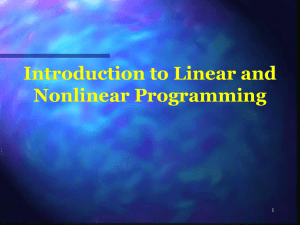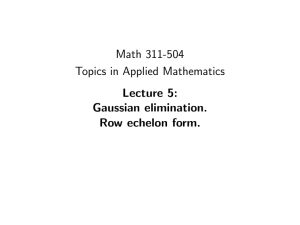MATH 304 Linear Algebra Lecture 2: Gaussian elimination.
advertisement
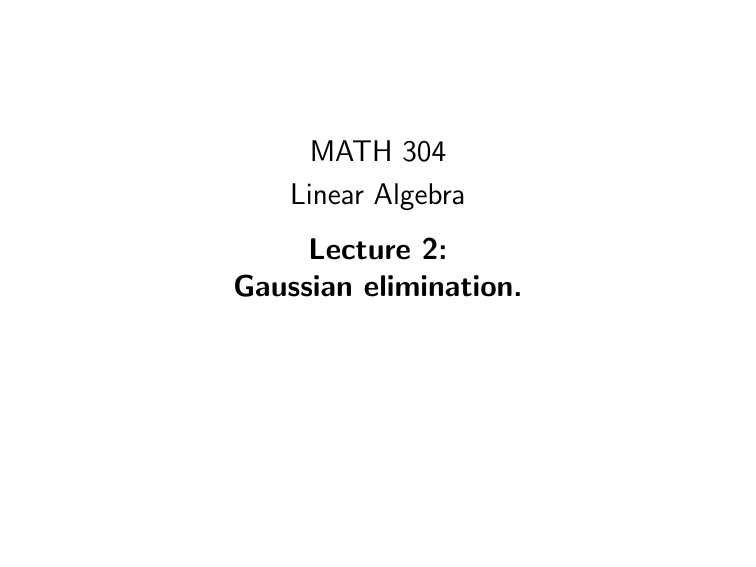
MATH 304 Linear Algebra Lecture 2: Gaussian elimination. System of linear equations a11 x1 + a12 x2 + · · · + a1n xn = b1 a21 x1 + a22 x2 + · · · + a2n xn = b2 ········· am1 x1 + am2 x2 + · · · + amn xn = bm Here x1 , x2 , . . . , xn are variables and aij , bj are constants. A solution of the system is a common solution of all equations in the system. A system of linear equations can have one solution, infinitely many solutions, or no solution at all. y x x − y = −2 2x + 3y = 6 x = 0, y = 2 y x 2x + 3y = 2 2x + 3y = 6 inconsistent system (no solutions) y x 4x + 6y = 12 ⇐⇒ 2x + 3y = 6 2x + 3y = 6 Solving systems of linear equations Elimination method always works for systems of linear equations. Algorithm: (1) pick a variable, solve one of the equations for it, and eliminate it from the other equations; (2) put aside the equation used in the elimination, and return to step (1). x − y = 2 =⇒ x = y + 2 2x − y − z = 5 =⇒ 2(y + 2) − y − z = 5 After the elimination is completed, the system is solved by back substitution. y = 1 =⇒ x = y + 2 = 3 Gaussian elimination Gaussian elimination is a modification of the elimination method that allows only so-called elementary operations. Elementary operations for systems of linear equations: (1) to multiply an equation by a nonzero scalar; (2) to add an equation multiplied by a scalar to another equation; (3) to interchange two equations. Theorem Applying elementary operations to a system of linear equations does not change the solution set of the system. Operation 1: multiply the ith equation by r 6= 0. a11 x1 + a12 x2 + · · · + a1n xn = b1 ············ ai1 x1 + ai2 x2 + · · · + ain xn = bi ············ am1 x1 + am2 x2 + · · · + amn xn = bm a11 x1 + a12 x2 + · · · + a1n xn = b1 ············ (rai1 )x1 + (rai2 )x2 + · · · + (rain )xn = rbi =⇒ ············ am1 x1 + am2 x2 + · · · + amn xn = bm To undo the operation, multiply the ith equation by r −1 . Operation 2: add r times the ith equation to the jth equation. ············ ai1 x1 + ai2 x2 + · · · + ain xn = bi ············ =⇒ a x + aj2 x2 + · · · + ajn xn = bj j1 1 ············ ············ ai1 x1 + · · · + ain xn = bi ············ (a + rai1 )x1 + · · · + (ajn + rain )xn = bj + rbi j1 ············ To undo the operation, add −r times the ith equation to the jth equation. Operation 3: interchange the ith and jth equations. ············ ai1 x1 + ai2 x2 + · · · + ain xn = bi ············ a x + aj2 x2 + · · · + ajn xn = bj j1 1 ············ ············ aj1 x1 + aj2 x2 + · · · + ajn xn = bj ············ =⇒ a x + ai2 x2 + · · · + ain xn = bi i1 1 ············ To undo the operation, apply it once more. Example. = 2 x − y 2x − y − z = 3 x + y + z = 6 Add −2 times the x − y y − z x + y + z 1st equation to the 2nd equation: = 2 = −1 = 6 R2 := R2 − 2 ∗ R1 Add −1 times the 1st equation to the 3rd equation: = 2 x − y y − z = −1 2y + z = 4 Add −2 times the 2nd equation to the 3rd equation: = 2 x − y y − z = −1 3z = 6 The elimination is completed, and we can solve the system by back substitution. However we may as well proceed with elementary operations. Multiply the 3rd equation by 1/3: = 2 x − y y − z = −1 z = 2 Add the 3rd equation to the 2nd equation: = 2 x − y y = 1 z = 2 Add the 2nd equation to the 1st equation: = 3 x y = 1 z = 2 System of linear equations: =2 x −y 2x − y − z = 3 x +y +z =6 Solution: (x, y , z) = (3, 1, 2) Another example. x + y − 2z = 1 y − z = 3 −x + 4y − 3z = 1 Add the 1st x + y y 5y equation to the 3rd equation: − 2z = 1 − z = 3 − 5z = 2 Add −5 times the 2nd equation to the 3rd equation: 1 x + y − 2z = y − z = 3 0 = −13 System of linear equations: x + y − 2z = 1 y −z =3 −x + 4y − 3z = 1 Solution: no solution (inconsistent system). Yet another example. x + y − 2z = 1 y − z = 3 −x + 4y − 3z = 14 Add the 1st x + y y 5y equation to the 3rd equation: − 2z = 1 − z = 3 − 5z = 15 Add −5 times the 2nd x + y − 2z = y − z = 0 = equation to the 3rd equation: 1 3 0 Add −1 times the 2nd equation to the 1st equation: − z = −2 x x =z −2 y − z = 3 ⇐⇒ y =z +3 0 = 0 Here z is a free variable. x = t −2 It follows that y =t +3 z =t for some t ∈ R. System of linear equations: x + y − 2z = 1 y −z =3 −x + 4y − 3z = 14 Solution: (x, y , z) = (t − 2, t + 3, t), t ∈ R. In vector form, (x, y , z) = (−2, 3, 0) + t(1, 1, 1). The set of all solutions is a line in R3 passing through the point (−2, 3, 0) in the direction (1, 1, 1). Matrices Definition. A matrix is a rectangular array of numbers. 2 7 2 7 0.2 , Examples: −1 0 , 4.6 1 1 3 3 3/5 √ √ 1 1 5/8 , ( 2, 0, − 3, 5), . 0 1 4 dimensions = (# of rows) × (# of columns) n-by-n: square matrix n-by-1: column vector 1-by-n: row vector System of linear equations: a11 x1 + a12 x2 + · · · + a1n xn = b1 a21 x1 + a22 x2 + · · · + a2n xn = b2 ········· am1 x1 + am2 x2 + · · · + amn xn = bm Coefficient matrix and column vector of the right-hand sides: b1 a11 a12 . . . a1n a b2 21 a22 . . . a2n .. .. .. . . . .. . . . . bm am1 am2 . . . amn System of linear equations: a11 x1 + a12 x2 + · · · + a1n xn = b1 a21 x1 + a22 x2 + · · · + a2n xn = b2 ········· am1 x1 + am2 x2 + · · · + amn xn = bm Augmented a11 a12 a 21 a22 .. .. . . am1 am2 matrix: . . . a1n b1 . . . a2n b2 .. . . . ... . . . . amn bm Elementary operations for systems of linear equations correspond to elementary row operations for augmented matrices: (1) to multiply a row by a nonzero scalar; (2) to add the ith row multiplied by some r ∈ R to the jth row; (3) to interchange two rows. Remark. Rows are added and multiplied by scalars as vectors (namely, row vectors).
